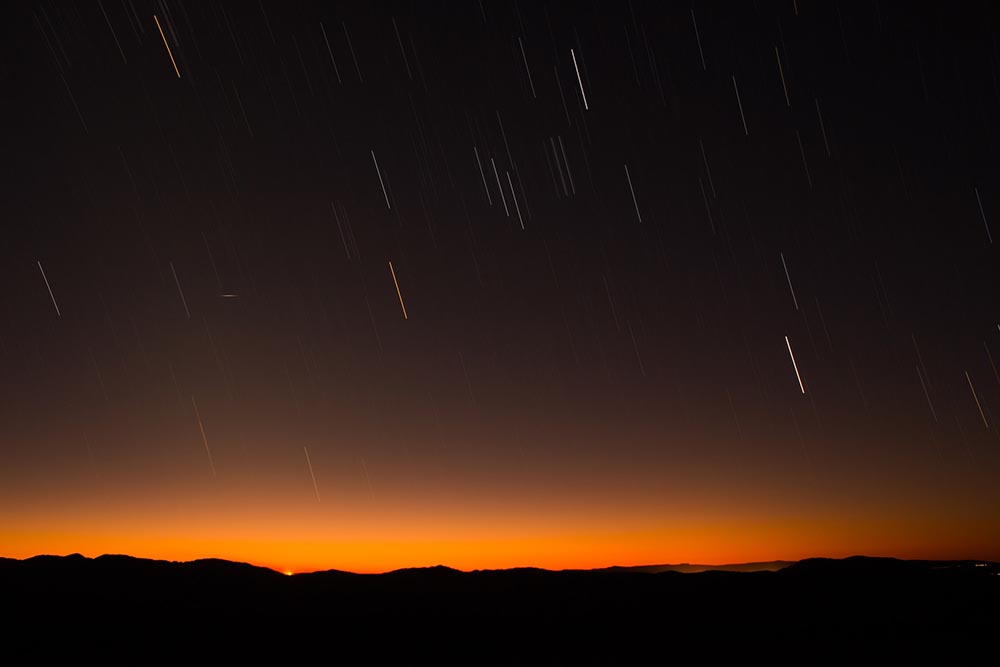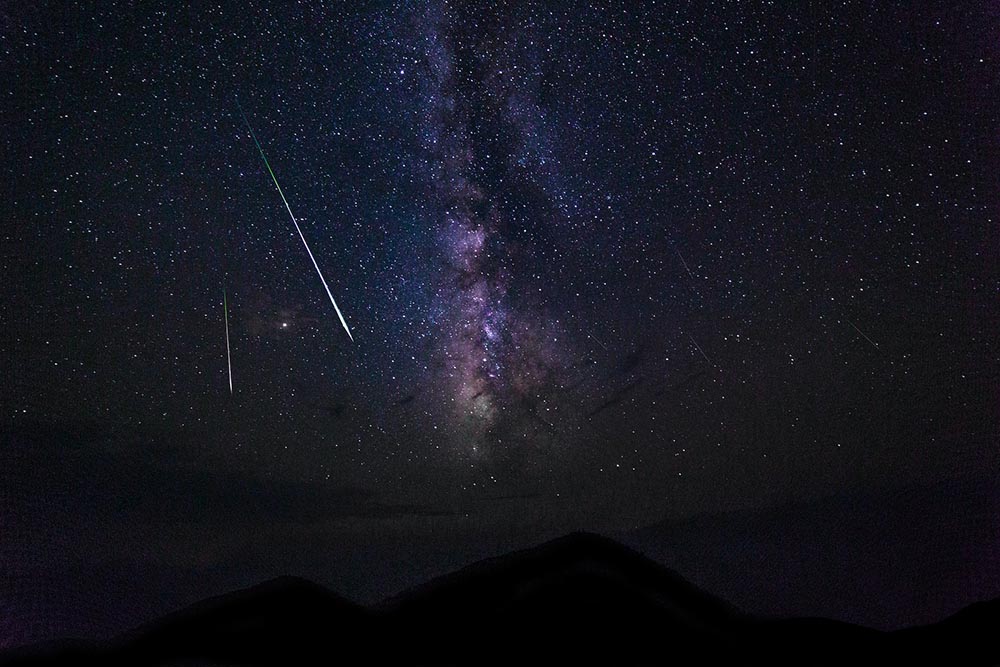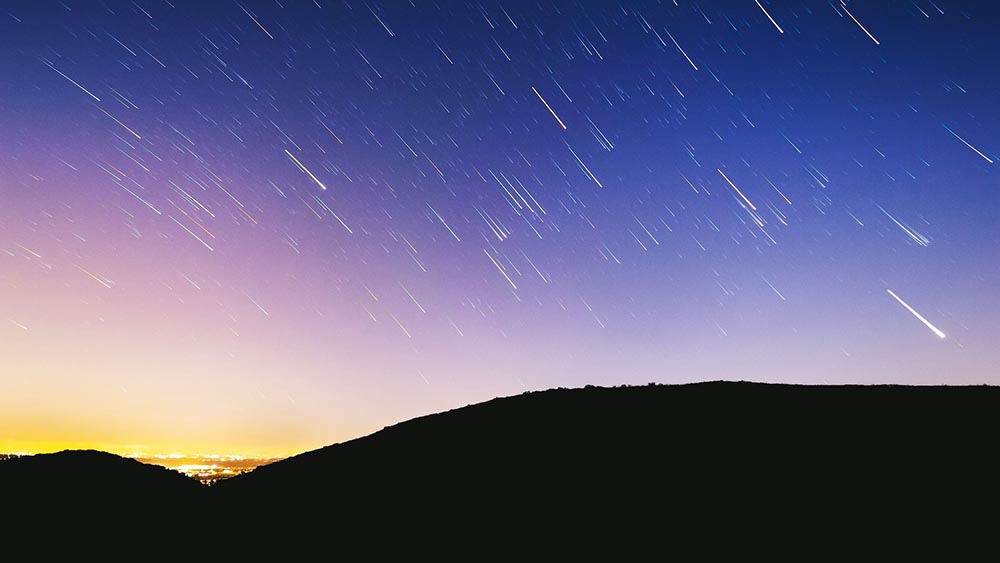What Is a Meteor Shower? What You Need to Know!
Last Updated on

A meteor shower is a celestial event visible from our planet. Meteors (space rocks) are seen streaking through the sky and originate from one spot. While these meteors are smaller than a grain of sand, they burn bright when passing through Earth’s atmosphere. You don’t need special equipment to enjoy a meteor shower.
There have been contradicting theories explaining meteor showers and why we sometimes see them at night. According to Aristotle, meteor showers were exhalations from our planet’s surface. Studies over the years using more advanced technology and equipment suggest that they originate beyond Earth.

Meteor Showers Defined
Meteors or meteoroids are small space rocks, dust, or comet particles that break into Earth’s atmosphere at extremely high speed. A meteor shower is when many meteoroids enter the Earth’s atmosphere at the same time.
Once the meteors enter our atmosphere, the friction between them and air particles makes them extremely hot. They leave behind a bright streak when they shoot across the sky, which we call “shooting stars.” Even though most meteors burn up entirely before hitting Earth’s surface, some meteorites are so large that they survive the fall.

Where Do Meteor Showers Come From?
The Earth and other celestial bodies like comets and planets orbit the sun. Planets have a somewhat perfect circle orbit, meaning their particles and debris are less likely to wander into space. However, comets are uneven, increasing the odds of rocks and dust particles flying into space as they orbit closer to the sun.
The sun’s surface is approximately 10,000 degrees hot. Comets heat up as they travel closer to the sun and while some parts vaporize, other particles of dust, rock, and debris remain on the comet’s pathway. Earth experiences a meteor shower when it passes through a path with comet debris.
Because of the direct heat from the sun, most comet particles are hardly larger than a grain of sand. When Earth orbits along a comet path, the debris and particles are strewn out and into our atmosphere. These are called meteors. Hundreds of meteors can enter Earth’s atmosphere at a predictable time each year during meteor showers.
Types of Meteor Showers
Sometimes when there are no clouds at night, you see a tiny streak of light flashing across the sky. While most people call it a shooting star, it is a small space rock that enters the Earth’s atmosphere. During certain times of the year, many tiny space rocks enter our atmosphere simultaneously, creating a fleeting light show — a meteor shower.
A meteor shower originates from the same angle called the radiant point. Generally, the meteor’s tails seem to stem from the same spot. Scientists name meteor showers based on the constellation they seem to originate from.
Here are some of the common types of meteor showers:
Geminids
Geminids offer the best meteor shower show and occur annually in mid-December. They originate from 3200 Phaethon, and about 120 meteors fall each hour at 22 miles per second. Geminids have been active since the mid-1800s and are visible globally. The meteor shower starts in the early evenings allowing everyone to enjoy the spectacular sight.
Quadrantids
Quadrantids provide a spectacular view, especially from the Northern Hemisphere. They occur between late December and early January and provide a meteor shower of about 80 meteors per hour.
Lyrids
Astronomers have observed Lyrids meteor showers for over 2,700 years. They are among the oldest known meteor showers and can be traced back to 687 B.C. These showers occur in mid-April and leave a brilliant and colorful dust trail of Comet 1861 G1 Thatcher. About 20 meteors fall per hour.
Orionids
Between late October and early November, you can observe Orionids, especially if you are in areas around the Northern and Southern hemispheres. Orionids are best seen after midnight and originate from comet 1P/Halley, with 50 to 70 meteors falling during the meteor shower.
Draconid
The Draconid shower, also known as the Giacobinids meteor shower, has its radiant point at the highest sky. This means it’s highly visible during the evening hours. Draconid’s parent comet is 21P/Giacobini-Zinner, and the meteor shower occurs in October.
Typically Draconid showers are not the most spectacular, and only ten languid meteors fall per hour. However, sometimes the shower spews hundreds of meteors per hour. In 2011, for instance, observers saw about 600 meteors per hour.
Leonids
Leonids are best viewed in mid-November. They offer a jaw-dropping scene with their bright and colorful streaks. Comet 55P/Tempel-Tuttle is the parent comet of Leonids, and about 15 meteors fall every hour at a velocity of 77 kilometers per hour.
Leonid meteor showers are famous for their spectacular meteor storms. On November 17, 1966, the meteor shower dropped thousands of meteors per minute, making it the greatest meteor storm on record. Those that witnessed it got the impression that Earth had lost its axial footing.
Perseids
The Perseid meteor shower offers a spectacular cosmic light show between July and August each year. The meteor shower lights up the skies during moonless nights with no clouds. Unfortunately, we expect a full moon between mid-July and late August this year, meaning the skies will not be as illuminated as in 2021.
This year’s Perseid meteor shower is expected to occur in August, and its predicted peak is on August 13, 2022, at 3 UTC. It’s an all-or-nothing event, and the radiant point from which the meteors will appear to emanate will be at the heart of the sky. While there is no particular area of the sky you should look at, it makes sense to be on the lookout so that you don’t miss it.
Perseids originate from comet 109P/Swift-Tuttle. While the shower drops about 60 meteors per hour at 59 kilometers per hour, Earth experienced an outburst of 150 to 200 meteors falling per hour in 2016.
Astronauts do an outstanding job at giving meteor shower forecasts. You can plan ahead and note major star shows’ expected dates and peak viewing times. Just note that some years have more spectacular meteor showers than others, depending on how cloudy it is and the size of the moon during an event.

Meteor Shower FAQs
You can watch meteor showers from anywhere, and the streaks of light can appear from different locations, not just the radiant. However, some locations, especially around both hemispheres, tend to be better viewing spots. Here are the answers to three frequently asked questions about meteor showers:
Should I Worry for My Safety During Meteor Showers?
Most meteors, even during spectacular meteor showers, burn up before hitting the ground. You don’t face any significant threat, although you should beware that small amounts of material survive the fall occasionally. Any material that makes it to Earth’s ground is called a meteorite.
Most meteor showers feature a group of high-flying, silent shooting stars. You don’t need to get spooked while watching a meteor outburst or storm.
Do I Need to Protect My Eyes When Watching Meteor Showers?
Meteor showers feature multiple “shooting stars” originating from a radiant. Some meteor storms are bright and colorful, although this does not imply that watching them with your naked eyes can cause any harm. Generally, you do not need any special equipment to enjoy the free celestial event.
Can I Watch a Meteor Shower When The Skies Are Not Dark and Clear?
Yes. However, the show will not be as spectacular as it would be with dark and clear skies. The best location to watch a meteor shower is around sites that are away from the city’s bright lights. While you cannot do much to make the weather cooperate and give you clear skies, you can always consider going for a countryside campout to get the best view.

What Is the Estimated Duration of a Meteor Shower?
Several factors dictate the estimated duration of a meteor shower. These factors include the composition, density, and age of the comet debris stream. For instance, Quadrantids typically last for a few hours. Meteor storms occur for an hour or two at most.
How Frequently Do Meteor Showers Occur?
Each year, about 30 meteor showers are visible from Earth. Meteor showers like Perseid have existed for millennia and still occur annually in August.
Five Fun Facts to Remember
- Meteor showers are named after the constellation where their radiant originates
- A meteor shower occurs when Earth travels on a comet or asteroid’s debris trail
- If a meteor makes it to the Earth’s surface, it is called a meteorite
- Fireball meteors are brighter than Venus (the brightest of the five planets visible from Earth)
- Astronauts can predict when and where meteor showers will occur

Final Thoughts
Humans have observed shooting stars and meteor showers for millenniums. One of the oldest documented observations was recorded in A.D. 902 following the death of Abu Ishaq Ibrahim II. Modern scientists can make meteor shower forecasts today, enabling you to enjoy a dazzling star show several times a year.
The critical point to remember is meteor showers have unique characteristics, with December’s Geminids being the most spectacular. They light the sky with bright green, pink, and violet streaks. October Orionids are dim with a dull whitish-orange gleam but are the fastest! On the other hand, August Perseids are the most intense, with more meteors falling per hour.
Featured Image Credit: Fernando Rodrigues, Unsplash
About the Author Robert Sparks
Robert’s obsession with all things optical started early in life, when his optician father would bring home prototypes for Robert to play with. Nowadays, Robert is dedicated to helping others find the right optics for their needs. His hobbies include astronomy, astrophysics, and model building. Originally from Newark, NJ, he resides in Santa Fe, New Mexico, where the nighttime skies are filled with glittering stars.
Related Articles:
What Is the Best Binocular Magnification for Hunting? Optical Features Explained
15 Crucial Facts About Ultraviolet Rays & the Sun
What Constellation Is Spica In? The Interesting Answer!
10 Interesting Leo Constellation Facts, Myths, and FAQs
15 Interesting Pegasus Constellation Facts, Myths, and FAQs
6 Interesting Sagittarius Constellation Facts, Myths, and FAQs in 2024!
What Are Constellations? Where Did They Come From?
8 Interesting Libra Constellation Facts, Myths, and FAQs
